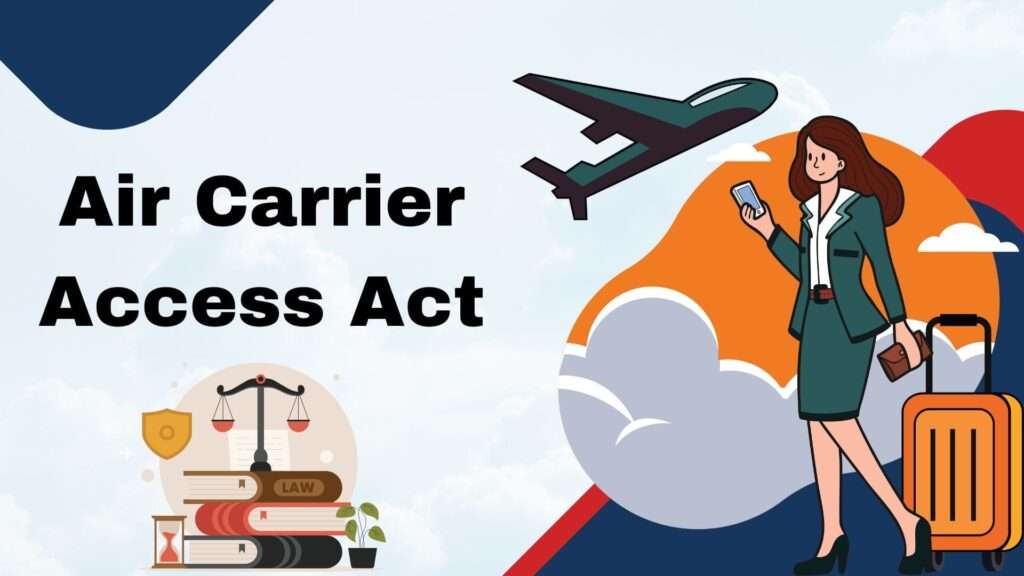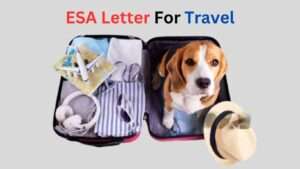Air Carrier Access Act
Air travel is a crucial means of transportation that connects people all over the world.
Many people use it to travel to new places, visit loved ones, or do business.
However, due to physical or cognitive limitations, not everyone has equal access to this means of transportation.
The Air Carrier Access Act (ACAA) comes into play here.
This blog post will explain what the ACAA is and why it is so important in maintaining accessibility in air travel.

What is the Air Carrier Access Act?
The Air Carrier Access Act, sometimes known as the ACAA, is a significant piece of legislation that was passed in 1986.
It is a federal statute in the United States that forbids handicap discrimination in air travel.
The ACAA applies to domestic and international flights conducted by US carriers or foreign carriers departing or arriving in the US.
The ACAA’s scope is broad, addressing a wide range of issues concerning air travel accessibility. Its main provisions are as follows:
1- Nondiscrimination
The ACAA assures that people with disabilities have equal access to air transportation services.
Airlines are not allowed to discriminate against passengers with impairments.
2- Airport Facility Accessibility
It requires accessibility in airport facilities such as terminals, boarding areas, and baggage claim.
This involves making accessible facilities, elevators, and communication systems available to people with hearing or vision impairments.
3- Aircraft Accessibility
Airlines are mandated to make their aircraft accessible to disabled passengers. This includes enough room for people using mobility aids, accessible restrooms, and assistance with boarding and deplaning.
4- Service and Emotional Support Animals
The ACAA covers the rights of travelers traveling with service animals or emotional support animals (ESAs) and specifies criteria for their accommodation.
5- Advance Notice and Accommodation Requests
Passengers with disabilities can request specific modifications ahead of time, and airlines are expected to respond promptly and provide reasonable accommodations.
The Importance of ACAA
The ACAA is extremely important for various reasons:
1- Equal Access
It ensures that people with disabilities have the same opportunity to travel by air as people without impairments. This encourages diversity and equal access to air transport services.
2- Safety and Dignity
The ACAA’s requirements ensure the safety and dignity of disabled passengers. It guarantees that they have access to the appropriate amenities and help when traveling.
3- Independence
By ensuring accessible facilities and services, the ACAA allows people with disabilities to travel independently, lessening their reliance on others.
4- Legal Protections
Passengers with disabilities can seek legal redress if they are subjected to discrimination or are denied accommodations, holding airlines accountable for following the law.
5- Global Impact
While a U.S. statute, the ACAA has a global influence because it applies to international flights arriving or departing from the United States. This encourages multinational airlines to implement comparable accessibility standards.
Summary
As a cornerstone of air travel accessibility, the Air Carrier Access Act is critical in ensuring that individuals with disabilities can participate in air travel without impediments.
Its provisions safeguard the rights, safety, and dignity of disabled passengers, making air travel a more inclusive and accessible method of transportation for all.
In an age where connectivity is critical, the ACAA ensures that no one is left out of seeing the globe through air travel.
Historical Background
The ACAA’s roots can be traced back to the 1970s disability rights movement.
People with disabilities, their advocates, and organizations began to struggle for equal rights and accessibility in various sectors of life, including transportation, during this century.
The activism of people like Judy Heumann, a disability rights advocate who, together with others, organized rallies and demonstrations to raise attention to the issues encountered by persons with disabilities, was a crucial driver for change.
These initiatives were recognized on a national and international scale, and they contributed to the push for legislative reform.
The ACAA itself became law in 1986, marking a watershed point in the fight for air travel accessibility.
Here are some significant milestones and amendments in the ACAA’s history:
1- Initial Enactment (1986)
On October 2, 1986, President Ronald Reagan signed the Air Carrier Access Act into law.
It banned disability discrimination in air travel and created the framework for accessibility criteria.
2- Accessible Airport amenities
The ACAA has been updated over the years to incorporate specific regulations for accessible airport amenities.
This assures that terminals, boarding areas, and other airport facilities are accessible to those with impairments.
3- Aircraft Accessibility
The ACAA has been amended to address aircraft accessibility.
This covers accessibility regulations for restrooms, storage of mobility devices, and provisions for passengers with mobility disabilities.
4- Service Pets and Emotional Support Animals
The ACAA has been revised to explain the rights of passengers traveling with service or emotional support animals (ESAs).
These regulations make it easier for airlines and passengers to understand their respective responsibilities when it comes to service animals.
5- Advance Notice and Accommodation Requests
The ACAA has evolved to develop clear procedures for travelers with disabilities to request accommodations in advance of their travel.
Airlines are expected to react to these requests as soon as possible and to make reasonable arrangements.
6- Penalties and Enforcement
Amendments have increased the ACAA’s enforcement, allowing passengers to seek legal redress for infractions.
Penalties for noncompliance have been enhanced in order to encourage airlines to follow the law.
7- Recent Developments
Recent innovations and amendments ensure that the ACAA remains relevant in the ever-changing context of air travel and disability rights.
Who Does ACAA Protect?
The ACAA provides protection to a wide spectrum of people, including:
1- Passengers with Disabilities
Passengers with disabilities are the principal beneficiaries of the ACAA.
Individuals with physical disabilities, sensory impairments (such as blindness or deafness), cognitive disabilities, mental health issues, and other conditions are all included.
The ACAA understands that disabilities vary and that the requirement for accommodations differs from person to person.
2- Companions
The ACAA understands that many disabled travelers may require the support of companions or personal care attendants.
Companions are likewise protected under the ACAA and have the right to travel with the passenger they are aiding, whether they are family members, friends, or professional carers.
3- Service Animals
Passengers who rely on service animals are protected under the ACAA.
Service animals, such as guide dogs for the blind or hearing dogs for the deaf, are particularly trained to perform duties for people with impairments.
Airlines must transport these animals in the cabin with their owners.
4- Emotional Support Animals (ESAs)
Individuals with mental health issues who benefit from the presence of emotional support animals (ESAs) are also protected under the ACAA.
When ESAs are not the same as service animals, the ACAA provides rules for accommodating them when flying.
Types of Disabilities Recognized
The ACAA recognizes numerous disabilities, including but not limited to:
A- Mobility difficulties
Individuals with mobility difficulties (for example, those who use wheelchairs or mobility aids).
B- Sensory impairments
For example, blind or deaf people.
C- Cognitive impairments
Individuals with cognitive impairments (e.g., those with intellectual disabilities or cognitive illnesses).
D- Mental illnesses
Individuals suffering from mental illnesses (for example, depression, anxiety disorders, sadness, or PTSD).
E- Chronic Health Conditions
Individuals with chronic health conditions (for example, those who require medical equipment or accommodations).
The ACAA emphasizes that disability should not be a barrier to air travel and that accommodations should be made to ensure that all passengers have a smooth and accessible voyage.
Summary
The Air Carrier Access Act is a shining example of equality in the world of air travel.
It assures that the skies are available to everyone by protecting passengers with impairments, their friends, and their assistance animals.
This legislation expresses the notion that everyone, regardless of physical or cognitive abilities, should be able to travel around the world, visit loved ones, or conduct business through air travel.
It serves as a reminder of our dedication to diversity and equal access to critical services.
Key Provisions of the ACAA
In this portion, we will look at the ACAA’s essential provisions and their importance in encouraging accessibility and inclusivity in air travel.
1- Air Travel Nondiscrimination
One of the ACAA’s main principles is the prohibition of discrimination against people with impairments in air travel. Airlines are expressly forbidden from:
A- Refusing to give air transport to disabled people because of their handicap.
B- Imposing limits or limitations that do not apply to all travellers.
C- Requiring early notification merely due to the infirmity of a traveller.
This clause ensures that disabled passengers have the same opportunity and access to air travel services as any other passenger.
2- Facility and service accessibility
The ACAA understands that accessibility extends beyond the aircraft. It requires airport facilities and services to be accessible to people with impairments. This includes the following:
A- Providing passengers with mobility impairments with access to airport terminals, gates, boarding areas, and baggage claim areas.
B- Providing easily accessible restrooms.
C- Providing suitable signage and communication methods for passengers with sensory impairments (such as blindness or deafness).
These requirements ensure that passengers can access the whole air travel experience, from the moment they enter the airport until they arrive at their destination.
3- Access to Aircraft
The ACAA creates particular aircraft accessibility requirements to ensure that passengers with impairments can travel by air comfortably and securely.
These requirements include:
A- There is enough room for travelers who use wheelchairs or other mobility devices.
B- Lavatories that are accessible and include the essential support elements.
C- Passengers with mobility problems may board and deplane the airplane.
These regulations ensure that people with impairments can travel by plane without excessive burden or discomfort.
3- Service animals and emotional support animals
The ACAA protects the rights of passengers who travel with service animals or emotional support animals (ESAs).
While service animals, such as guide dogs or hearing dogs, are expressly trained to perform tasks for people with impairments, emotional support animals, or ESAs, provide emotional support and comfort.
The ACAA provides standards for accommodating both types of animals, guaranteeing that passengers with disabilities are able to travel with their necessary companions.
4- Requests for Advance Notice and Accommodations
Passengers with impairments can use the ACAA to request special accommodations ahead of time.
Airlines are expected to react to these requests as soon as possible and to make reasonable arrangements.
This provision guarantees that passengers receive the assistance they require and that airlines are ready to meet those requirements.
Understanding Advance Notice
The ACAA recognises that people with impairments may require special accommodations and assistance when flying.
These accommodations might range from wheelchair assistance to communication aid for people with sensory impairments.
The ACAA permits passengers to request certain accommodations in advance to guarantee that airlines can appropriately prepare for and supply them.
Types of Accommodation Requests
A)- Wheelchair or Mobility Assistance
Passengers who need wheelchairs or other mobility aids can request assistance with boarding, deplaning, and traversing the airport.
B)- CCommunication Support
The ACAA mandates airlines to provide appropriate communication for passengers with hearing impairments.
This could entail using sign language interpreters or written communication.
C)- Passengers with vision Impairments
Airlines must assist passengers with vision impairments by guiding them around the airport and assisting them with boarding and deplaning.
D)- Medical Accommodations
Passengers with medical illnesses who require particular medical accommodations, such as supplementary oxygen or seating arrangements, can request these in advance.
Requesting Accommodations
Passengers with disabilities can request accommodations while booking their flights or at least 48 hours before departure.
It is critical to give airlines adequate warning so that required preparations can be undertaken.
Prompt Responses and Reasonable Accommodations
When a disabled passenger submits an accommodation request, the airline is obligated to respond quickly and properly.
This means that airlines must acknowledge the request and make every effort to accommodate it.
Reasonable accommodations do not place an excessive burden on the airline or fundamentally alter the character of its services.
Providing a wheelchair to a passenger or arranging seating to accommodate a guide dog, for example, would be deemed reasonable accommodations.
Rights of Passengers with Disabilities
Make a clear request for the accommodations they require.
Receive a prompt response from the airline to their requirements.
Travel without fear of discrimination or impediment because of their impairments.
Traveling with Service Animals and ESAs
Travelling with a service animal or emotional support animal (ESA) can provide crucial help and comfort to people with disabilities.
The Air Carrier Access Act (ACAA) recognises the value of these creatures and gives rules for their care while flying.
In this part, we’ll look at the ACAA’s laws for travelling with service animals and ESAs, which ensure that travellers with disabilities can enjoy air travel with their trusty friends.
Service Animals vs Emotional Support Pets
Before delving into the ACAA’s regulations, it’s critical to understand the difference between service animals and emotional support animals:
Service animals
Service animals are specifically trained animals that perform specialised jobs to aid people with impairments, such as guide dogs for the blind or hearing dogs for the deaf.
They are permitted to accompany their owners in the aircraft’s cabin.
Emotional Support Animals (ESAs)
ESAs provide emotional support and comfort to people suffering from mental illnesses such as anxiety or depression.
While ESAs are not certified to do certain duties, the ACAA recognises them and allows them to fly under specified conditions.
ACAA Guidelines for Service Animals
The ACAA ensures that disabled travellers can travel with their service animals by:
1- Allowing Service Animals in the Cabin
Service animals are usually allowed to join their owners in the aircraft cabin.
This enables passengers with disabilities to have their necessary companions with them during the flight.
2- No additional payments
Airlines are not permitted to charge additional fees for service animals travelling in the cabin.
3- Documentation
While paperwork is not necessary for service animals, airlines may request genuine verbal assurance from passengers that their animal is a trained support animal.
4- Animal Behaviour
Service animals must always be under control and well-behaved.
If an animal exhibits disruptive or aggressive behaviour, the airline may take action to guarantee all passengers’ safety and comfort.
ACAA Guidelines for Emotional Support Animals (ESAs)
The ACAA also recognizes ESAs, but with additional requirements:
1- Documentation
Passengers traveling with an ESA must give the required documentation to the airline at least 48 hours in advance.
This documentation should include an ESA letter from a licensed mental health expert stating the passenger’s need for an ESA.
2- Well-Behaved Animal
ESAs, like service animals, must behave well during flying. Airlines may take action if the animal poses a safety risk or causes inconveniences.
Accessible Airport Facilities
The Air Carrier Access Act (ACAA) acknowledges the need of accessible airport facilities and requires airports to meet particular accessibility standards.
In this part, we will look at the ACAA’s accessibility rules and their role in encouraging inclusion in air travel.
Terminal Accessibility and Services
A- Accessible Entrances
The ACAA requires airports to provide easily accessible entrances.
To assist travellers with mobility impairments, these entrances should be outfitted with ramps, lifts, or other accessible amenities.
B- Restrooms with Disabilities
Restrooms in airport terminals must be accessible to travellers with disabilities.
This features wide stalls, grab bars, and enough signage for people with visual impairments.
C- Communication Support
Airports are required to provide communication support to travellers with sensory impairments.
Sign language interpreters, captioning services, and communication aids are examples of such services.
D- Accessible Seating places
To accommodate passengers with disabilities, airport terminals must offer accessible seating places.
These locations should be well signposted and include seating with wheelchair clearances.
Boarding and Deplaning Assistance
A- Boarding Assistance
Airlines and airport workers must help disabled passengers in boarding the aircraft.
This involves providing boarding ramps or lifts as needed, as well as ensuring that passengers are seated safely and comfortably.
B- Deplaning Assistance
Similarly, help must be offered during the deplaning procedure to ensure that passengers with disabilities exit the aircraft safely and effectively.
C- Assistance with Airport Navigation
Airport workers should be available to assist travellers with disabilities with airport navigation, including escorting them through security checks and to their gates.
Accessible Services for All Passengers
The ACAA emphasises the significance of making accessible services available to all passengers, regardless of disability.
This accessibility commitment extends to travellers with mobility impairments, sensory impairments, cognitive disabilities, and other disabilities.
The ACAA’s goal in adopting these measures is to ensure a seamless and inclusive airport experience for everyone.
Complaints and Enforcement
The Air Carrier Access Act (ACAA) is a cornerstone of ensuring individuals with disabilities equitable access to air travel.
While the ACAA establishes thorough accessibility and accommodation criteria, what happens when these guidelines are not followed?
This is where the complaints and enforcement provisions come into play. In this portion, we will look at how the ACAA handles complaints and the enforcement procedures in place.
Filing a Complaint Under ACAA
The ACAA recognizes that travelers with impairments may face accessibility or discrimination difficulties while flying.
The ACAA permits passengers to register complaints against airlines for alleged infractions in order to address these concerns. This is how the process usually goes:
A- Contact the Airline
If a passenger believes their ACAA rights have been infringed, the first action is to contact the airline involved.
Many difficulties can be remedied by contacting the airline’s customer service or complaint resolution departments directly.
B- File a Written Complaint
If the matter continues unresolved or the passenger is dissatisfied with the airline’s answer, they can file a written complaint with the United States Department of Transportation (DOT).
The DOT is in charge of ensuring that the ACAA is followed.
C- Include Specifics
Include precise data regarding the claimed infringement in the complaint, such as the date, flight number, airline, and description of the incident.
Providing supporting material, such as airline correspondence or witness accounts, might help to bolster the allegation.
D- DOT Investigation
When the DOT receives a complaint, it conducts an inquiry to determine if the airline violated the ACAA.
This inquiry may include interviews, document inspections, and correspondence with the airline.
Enforcement and Penalties
When it comes to enforcement, the ACAA is tough. Airlines found in breach of the ACAA may face the following penalties:
1- Civil Penalties
Airlines that violate the ACAA may be punished.
The degree and nature of the violation determine the specific punishments.
2- Corrective Action
In addition to fines, the DOT has the authority to order airlines to take corrective action in order to address the infractions and prevent future recurrence.
3- Damages to Passengers
Passengers may be entitled to damages, including compensation for any hurt or distress caused, if they have encountered discrimination or violations of their rights under the ACAA.
4- Operating right Revocation
In severe circumstances of noncompliance, the DOT has the right to suspend or withdraw an airline’s operating authority.
Amendments and Future Prospects
The Air Carrier Access Act (ACAA) has been a shining example of success in encouraging accessibility and inclusion in air travel for people with disabilities.
It has been amended over time to reinforce its provisions and adapt to changing demands.
In this blog part, we’ll look at some of the most recent changes to the ACAA as well as the prospects for future improvements in air travel accessibility.
Recent Amendments to the ACAA
The ACAA, which was first passed in 1986, has experienced many important revisions in recent years to better serve the requirements of disabled passengers:
A- Enhanced Service Animal Guidelines (2020)
The Department of Transportation (DOT) issued revisions in 2020 in response to concerns about the rising presence of emotional support animals (ESAs) on flights.
These amendments clarified the definition of a service animal and permitted airlines to limit ESAs, ensuring that travellers with legitimate service animals received the necessary accommodations.
B- Improved Accessibility Reporting (2020)
The DOT issued guidelines requiring airlines to submit statistics on the number of wheelchairs and scooters they handle, as well as the number of wheelchairs and scooters that are mishandled.
This greater transparency aids in identifying areas in which improvements are required.
C- In-Flight Entertainment Accessibility (2021)
New regulations force airlines to make in-flight entertainment systems accessible to disabled passengers. This ensures that all passengers have access to entertainment while flying.
Future Prospects for the ACAA
While the ACAA has achieved tremendous progress, there is still room for further development and expansion of its provisions:
A- Enhanced Training
Comprehensive training on aiding passengers with all forms of disability might benefit airlines and airport workers.
Improved training can help to ensure a consistent quality of service.
B- Technological Solutions
Technological advancements can improve accessibility even more. Technology, from smart airport apps to assistive equipment, can give novel answers to typical issues experienced by disabled travellers.
C- Global Accessibility Standards
Collaborative efforts between governments can lead to global accessibility standards for air travel, assuring uniformity and inclusivity for passengers with disabilities globally.
D- Passenger Input
Input from Passengers with Disabilities and Disability Advocacy Organisations:
Actively seeking input from passengers with disabilities and disability advocacy organisations will assist shape future revisions and ensure that the ACAA remains responsive to changing requirements.
E- Awareness and Education
Continued awareness efforts and education programmes can help enlighten disabled passengers about their rights and airlines about their responsibilities under the ACAA.
Final Thoughts
The recent revisions to the Air Carrier Access Act, as well as the potential for future enhancements, reflect a commitment to make air travel accessible to all.
The ACAA can continue to play a critical role in ensuring that people with disabilities may fly with dignity, comfort, and equitable access to air transportation by addressing developing issues and embracing new opportunities.
Looking ahead, it’s obvious that the road towards a more inclusive and accessible air travel experience is ongoing, and the ACAA continues to play an important role in that journey.
FAQs
What is the Air Carrier Access Act (ACAA)?
The Air Carrier Access Act is a federal law in the United States that outlaws disability discrimination in air travel and compels airlines to accommodate disabled passengers.
Does the ACAA cover emotional support animals (ESAs)?
Yes, the ACAA covers ESAs and allows individuals with valid ESA letters to travel in the cabin of an airplane with their emotional support animals.
What are the requirements for traveling with an ESA under the ACAA?
Passengers must provide a valid ESA letter from a licensed mental health professional and notify the airline in advance that they will be traveling with an ESA.
Can airlines charge fees for traveling with an ESA under the ACAA?
ESAs traveling in the cabin cannot be charged additional fees by airlines. However, passengers may still be liable for any pet expenses incurred as a result of bringing an ESA.
Do ESAs need to be placed in carriers during the flight?
ESAs are usually permitted to sit on a passenger’s lap or on the floor during the trip, as long as they do not obstruct the aisle or other passengers.
Can airlines request additional documentation beyond the ESA letter under the ACAA?
Specific documents, such as a completed form provided by the airline, information regarding the ESA’s behaviour, and proof that the ESA will not pose a safety risk, may be requested.
Are there any restrictions on the types of animals that can be ESAs under the ACAA?
The ACAA makes no distinction between the categories of animals that can be ESAs. Airlines, on the other hand, may have their own standards regarding permissible ESA species and size.
Can passengers with ESAs be seated separately from other passengers?
Unless there are valid safety concerns or the ESA is too large to fit comfortably, airlines are not compelled to seat customers with ESAs away from other passengers.
Can airlines deny boarding to passengers with ESAs?
Passengers with ESAs may be denied boarding if the animal poses a direct threat to the health or safety of other passengers, participates in disruptive behaviour, or is not under control.
Are there any recent changes to ESA regulations under the ACAA?
Yes, the US Department of Transportation has amended restrictions regarding ESAs aboard aeroplanes as of 2021. Passengers should be aware of these changes and consult their airline for the most recent information on ESA travel.

Trusted Legal Advisor, Guiding Clients through Complex Legal Landscapes with Precision and Expertise.

ESA Letter Requirements If you are considering obtaining an Emotional Support Animal (ESA) and an ESA letter, understanding the requirements for obtaining such documentation is

ESA Letter Renewal If you already have an Emotional Support Animal (ESA) and an ESA letter, you may be wondering about the process of renewing

Get an ESA Letter In recent years, the concept of Emotional Support Animals (ESAs) has gained widespread recognition for their invaluable role in supporting individuals

The Role of ESAs in Addiction Recovery Addiction recovery is a challenging journey, often fraught with emotional highs and lows. While traditional therapies and medications

The Impact of ESAs on Reducing Panic Attacks Imagine facing overwhelming panic, your heart racing, your breath quickening, and feeling like the world is closing

ESAs for Senior Citizens In a world brimming with stressors and uncertainties, emotional support animals (ESAs) offer a beacon of comfort and companionship, especially for

ESAs for Children In the realm of emotional well-being, children often require unique forms of support to navigate the complexities of their feelings and experiences.

Public Spaces and ESA Access Rights Step into a world where companionship knows no boundaries and support is always by your side. In our bustling

How to Choose the Right ESA for Your Needs Emotional Support Animals (ESAs) play a crucial role in providing comfort, companionship, and support to individuals

No Pet Fees with ESA LetterA Comprehensive Guide Imagine finding your perfect furry companion, one that not only brings you joy but also provides vital

Benefits of an ESA LetterHow ESA Letters Help Unravel the world of comfort, companionship, and legal privileges as we delve into the benefits of having

Obtain ESA Letter for Your DogCertified ESA Letter for Canine Are you ready to unleash a world of comfort and companionship for you and your

Get Your Cat’s ESA LetterFeline ESA Letter Documentation Introducing your furry friend to the world of emotional support can be life-changing—for both of you. If

10 DIY Dog House IdeasFrom Simple to Stunning Welcome to the ultimate guide for dog lovers and DIY enthusiasts alike! Get ready to embark on

Socialization Tips for Your Dog From Shy to Social Socialization is like a superpower for your furry friend, shaping their behavior and happiness. From playful

Exercise for Your DogTail-Wagging Workouts Get ready to unleash the energy and excitement in your furry friend with tail-wagging workouts! Discover how exercising your dog

Dental Care for Your DogEssential Dental Care Tips Your dog’s dental health is more than just a pretty smile—it’s essential for their overall well-being. Just

Responsible Shock Collar UsageEffective Dog Training Embarking on the journey of shock collar training requires more than just the device itself. It demands a thoughtful

Dog Training with Shock Collar Train Smarter Embarking on the journey of dog training often leads us to explore various methods, with shock collar training

10 Human Foods Toxic to DogsCanine Health Hazard Unlock the secrets to a pet-friendly pantry! Dive into our guide on the 10 human foods that

DIY High Protein Dog Food Recipes Step into the kitchen and embark on a culinary adventure for your four-legged companion with our blog on DIY

Choosing the Right ProteinDiet for Dog Welcome to a canine culinary adventure! In our latest blog, ‘Choosing the Right Protein Diet for Dogs,’ we dive

How Much Protein Does Your Pup Need? Embark on a canine nutrition adventure with our latest blog – ‘How Much Protein Does Your Pup Need?’

The Benefits of High-ProteinDog Foods Embark on a journey to discover the incredible world of high-protein dog foods! Unleash the secrets behind the bowl, as

Dog Training BooksA Complete Guide Embark on a journey of canine education with our comprehensive guide to the best dog training books.Whether you’re a new

Dog Food For Diabetic Dogs Is your furry friend diagnosed with diabetes? Discover the best dog food options tailored to meet their unique nutritional needs.

Fiber Rich Dog FoodsA Complete Guide Dive into the world of fiber-rich dog foods with our complete guide. Explore the benefits of a high-fiber diet

Unhealthy Dog FoodsMust Read Guide Protect your furry friend from potential health hazards. Uncover the red flags in pet nutrition as we unveil the must-read

Healthy Dog FoodsA Comprehensive Guide Elevate your dog’s health and happiness with our detailed guide to nutritious canine diets. Uncover the secrets to selecting wholesome

High Protein Dog FoodsComplete List Fuel your dog’s vitality with our comprehensive list of high-protein dog foods. Discover the benefits of a protein-rich diet and

Dog Food AllergiesA Complete Guide Is your dog showing signs of food allergies? Unravel the mystery with our complete guide. Learn to identify, manage, and

Dog Training With CollarA Comprehensive Guide Explore the world of effective dog training with our comprehensive guide on using collars. Discover the right techniques and

Dog VestA Must-Read Guide For Pet Lovers Elevate your pet’s style and comfort with our must-read guide on dog vests. From fashion to functionality, explore

Dog HouseA Complete Guide For Pet Lovers Create the perfect sanctuary for your furry friend with our comprehensive guide to dog houses. From design considerations

Dog CrateA Comprehensive Guide For Pet Lovers Discover the importance of a well-chosen dog crate in your pet’s life. Our comprehensive guide provides insights into

Dog BedsEverything Pet Lovers Need To Know From size to style, our guide covers everything you need to know about providing the perfect bed for

Dog FoodA Complete Manual for Pet Enthusiasts Uncover the secrets of providing top-notch nutrition for your beloved pet. Our comprehensive manual covers everything you need

Why Only LMHPs Can Prescribe an ESA Letter? Join us on a journey to understand why only Licensed Mental Health Professionals (LMHPs) hold the key

Difference between Psychologists and Psychiatrists Dive into the intriguing realm of mental health as we unravel the nuances distinguishing psychologists and psychiatrists. Discover their unique

Can LMFTs Write an ESA Letter? Delve into the world of Emotional Support Animal (ESA) letters and discover the pivotal role Licensed Marriage and Family






